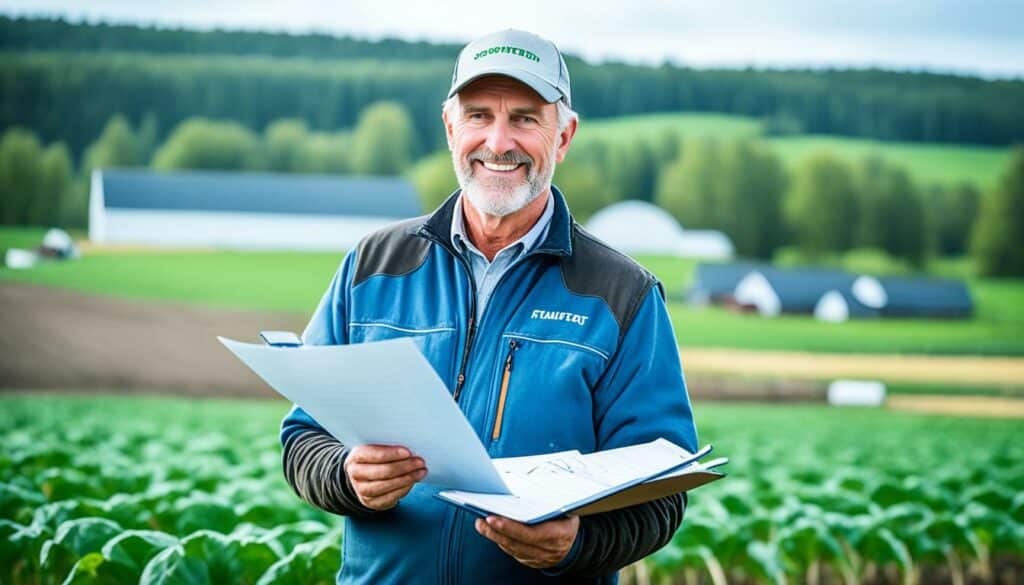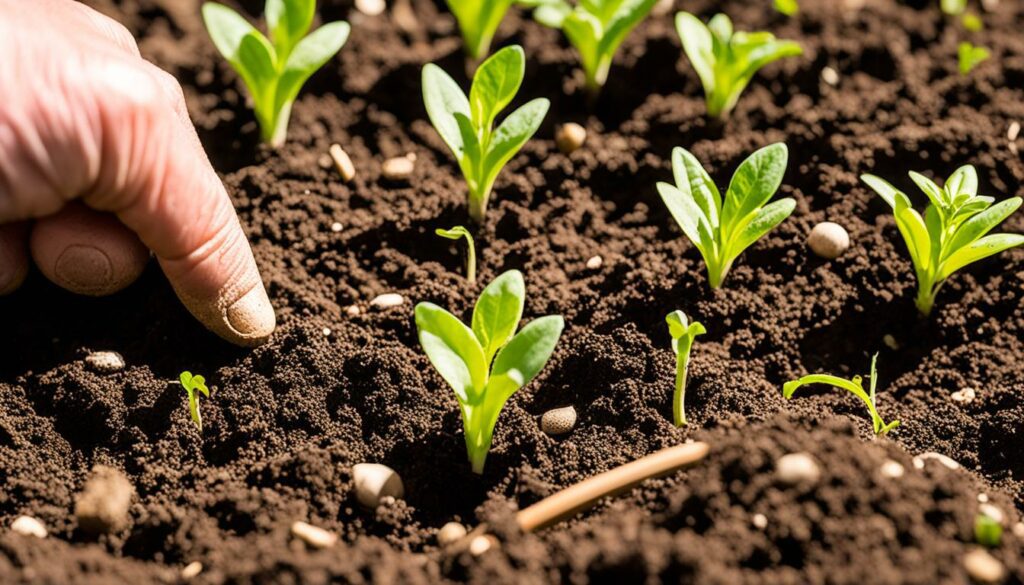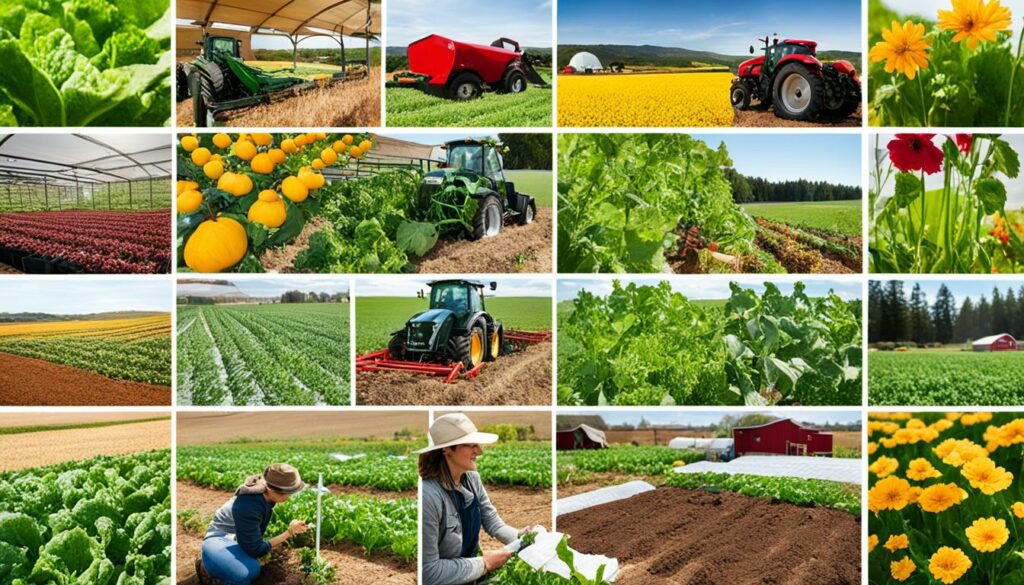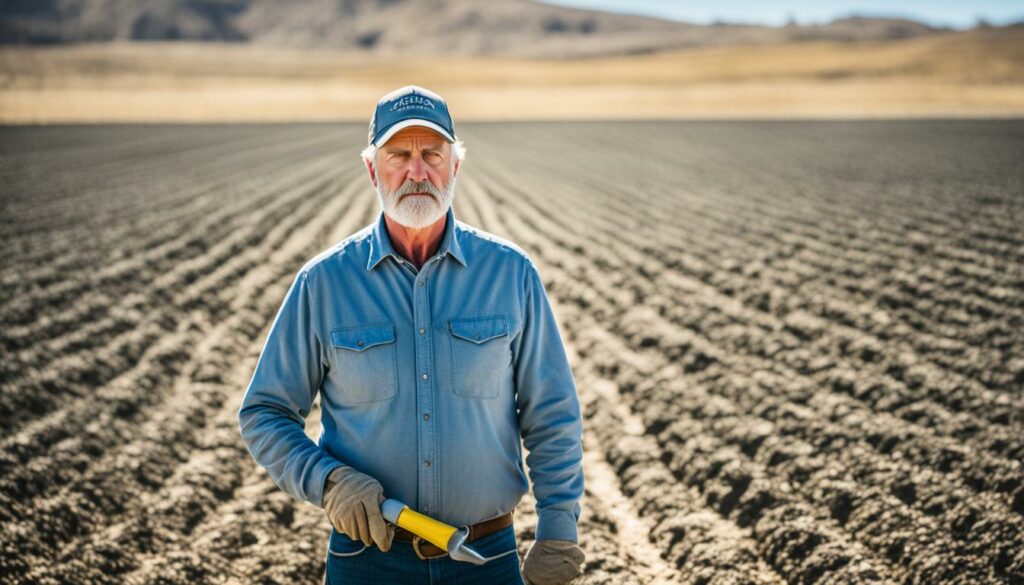Menu

Did you know that all of the Small Farm Funding Guide provides details on funding programs for both new and experienced farmers? This shows there’s a lot of help out there for anyone looking into grant application farming. Being good at applying for a grant is key to getting the funding you need for your agricultural projects.
It’s important to fully understand what each funding program asks for. You must carefully follow their instructions to avoid being turned down. Also, it’s vital to show you can finish reports and do what’s needed after getting the grant. This proves your project is serious and can have the impact you claim.
It’s key to know about different agricultural grants to apply successfully. Farmers and agribusiness owners have various funding sources. These include federal grants, state subsidies, and private funding. Each type has its own pros and cons.
The USDA manages federal grants for agriculture. Here, the USDA Farm Service Agency helps family farmers who need loans. They also offer loan guarantees. Meanwhile, the Risk Management Agency aims to stabilize the economy through risk management. Another example is the SCBGP. This program boosts the competitiveness of crops such as fruits and vegetables.
States offer their unique farm subsidies to help their specific agricultural goals. For instance, New York has the State Grown & Certified Infrastructure Grant. Missouri, on the other hand, provides the Urban Agriculture Cost-Share Grant Program. These funds help with upgrading infrastructure and supporting urban farming.
Various private groups also provide aid for farmers. For example, the Brighter Future Fund gives up to $10,000 for equipment or infrastructure. Then, The FruitGuys Community Fund offers up to $5,000 for improving farm operations. Other examples include grants for underrepresented farmers and those promoting humane farming.
Getting funding for farmers starts with knowing the rules. You must check if your project fits the grant’s goals. This includes what you’re doing, how big it is, and its location. For grants under the 2018 Agriculture Improvement Act, read and follow all the requirements exactly.

It’s vital to meet the criteria. This involves your farm’s size, the project’s focus, and its location.
The 2018 Agriculture Improvement Act highlights the start-up support for new farmers. It shows the special focus on this group.
Getting the grant application documents ready is key. You need a project plan, budget, and proof you are eligible.
Here’s what a full application includes:
Follow the rules for how you set up your documents. They need to be the right length, font, and layout. By being careful with grant application documents and ensuring you meet eligibility for agricultural grants, your chances of success go up.
For example, some grants offer as much as $24,000,000. But, only a quarter of the applications get funding. By paying close attention, you really improve your odds.
Before you apply, make sure you’re signed up on Grants.gov and SAM. Doing this groundwork right can help you get the funding for farmers you need.
Looking for grants for your farm? It’s key to find the right ones that fit your farm’s needs. Make sure to know what each fund requires to have a good chance of getting it. This step is very important for success.
Starting your grant search means looking into all possible options. The USDA’s NIFA has grants available. These include On-Farm Research Grants, giving up to $30,000 for two years. You can apply in September, and they announce winners in February. These grants want to see new, helpful ideas for farming.

| State | Projects Funded | Total Funding |
|---|---|---|
| Alabama | 10 | $127,779 |
| Arkansas | 13 | $209,458 |
| Florida | 31 | $503,453 |
| Georgia | 12 | $197,558 |
| Kentucky | 15 | $216,851 |
| Louisiana | 2 | $44,177 |
| Mississippi | 2 | $34,776 |
| U.S. Virgin Islands | 2 | $34,193 |
| North Carolina | 16 | $252,532 |
| Oklahoma | 8 | $113,934 |
| Puerto Rico | 3 | $42,473 |
| South Carolina | 10 | $142,377 |
| Tennessee | 7 | $114,772 |
| Texas | 21 | $358,398 |
| Virginia | 18 | $269,937 |
Geographic-specific grants are important. For instance, the Frontera Farmer Foundation helps organic farmers near Chicago. NIFA’s grants also change based on where you live. They support different farming needs across the country.
Talking to the people who give out grants can really help. They can explain exactly what they’re looking for in applications. Make sure to stay in touch through the whole process to get any help you might need.
Researching well and knowing your options is the best way to get funding. This approach can make a big difference for farmers wanting to start projects.
To succeed with a grant application, you need a strong strategy. Start by understanding what your farm needs. Then, look for grants that match those needs. Using storytelling to explain your project can really help.
For example, Northeast SARE offers grants from $5,000 to $30,000. You should focus on what makes your project special. Make sure your application stands out, as you only get one chance a year in the Northeast region.
Know the rules of the grants you apply for. For instance, Northeast SARE won’t pay for building costs. You can use their funds for research, paying staff, materials, and more. Make your proposal fit their rules to increase your chances.
Federal farm grants can be very generous. For renewable energy, they range from $2,500 to $1 million. For energy efficiency, it’s $1,500 to $500,000. The USDA might pay up to half. It’s key to show your project is clear and has lasting benefits.
Don’t forget about annual and final reports. When you get a Farmer Grant, you have to give solid data in these reports. Showing you understand this will make your application stronger.
Work on projects with others, especially with underserved groups. This can boost your application. Remember, Northeast SARE doesn’t want to fund the same project twice. So, make sure your idea is original.
Finally, start your proposal early and make sure it truly addresses a specific need. This approach is crucial for a successful grant application.
Taking the first steps in getting agricultural grants can feel big, especially for those just starting out. By aiming for small grants farming, a strong base can be formed. The USDA has given out over 8,400 microloans since 2013. Seventy percent of these went to new farmers. This shows the worth of starting small and moving forward bit by bit.

If you’re new, begin preparing your grant application early. Starting this process with plenty of time allows for research and edits. It’s best to spend about a month on your proposal, perfecting it through various versions. Setting up a timeline can make the whole thing less stressful.
Using help from well-known programs and data sources is another good idea in agricultural funding strategies. For example, the USDA’s Market News lets you keep an eye on prices for things like grass-fed beef and local foods. This helps smaller producers make smart choices. And, the Farm to School grants, which have had almost $10 million since 2013, can be a big help for local food projects.
It’s easy to see why starting with smaller grants is a popular choice. Thanks to the NRCS cost-share program since 2010, over 10,000 high tunnels have been set up. These tunnels help crops grow better and for longer. What’s more, special projects in five states are making it easier for farmers to get GAP certification. This helps them meet demands in the market.
Getting agricultural grants needs a well-thought-out plan and real effort. Looking at successes, such as those supported by the Frontera Farmer Foundation, can give good ideas. Their work with organic farmers in Chicago stresses the importance of choosing grants that meet your farm’s needs and goals.
Starting early, checking out the resources, and learning from others’ wins are key. It’s important to give each part of the application your full attention. This aims to increase your chances of getting the grant and making your project stand out.
| Program | Impact |
|---|---|
| Microloans | 8,400 issued; 70% to beginning farmers |
| Farm to School Grants | $10 million invested since 2013 |
| NRCS High Tunnel Program | 10,000 high tunnels contracted since 2010 |
| GAP Certification Pilots | Initiated in five states |
A compelling grant proposal is carefully crafted. It highlights the need, shows the farm challenges, and provides solutions. It also outlines how the solutions will produce measurable agricultural results. Knowing how to use these elements can increase your chance of getting the grant.
It’s vital to clearly state the need or challenge. Explain the specific problems your farm faces. Talk about how these issues impact your output and sustainability. This helps funders see why your project is important and how their support will help.
After defining the needs, you need to suggest solutions. Talk about the steps you will take to overcome the challenges. Make sure your solutions are practical and fit the funder’s goals. Doing this shows your team can succeed and has a clear plan.
Your proposal must also describe what you hope to achieve. Spell out clear goals such as better yields, saving resources, or financial gains. By showing how you will measure these results, you make your proposal more concrete and appealing.
By addressing these parts, your grant proposal becomes strong and convincing. You show you understand the problems, have a viable solution, and set clear goals. This makes funders more likely to support your project.
Using a strong narrative in your grant application is key. It can show farming issues clearly, alongside real solutions in agriculture. Storytelling in grants grabs the reader’s interest, making your proposal stand out and stay with them.

Start by making a story that your audience will connect with. Make sure it’s about the aims of your project. You can add data and facts to back up your story. Tools like Jotform and Airtable help you tell your story well. Using these facts to tell a moving story about farms is key.
Show clearly the farming issues you want to tackle in your grant proposal. Adding real stories can make the issue more lifelike to those reading your proposal. Make sure these stories match what big funding groups like NSF and NIH care about. This will make your proposal more appealing.
End your story with a clear solution. Choose solutions that make sense and are supported by data. This will show your team knows what they are doing. Adding photos and diagrams can help the reader see your ideas clearly.
Don’t forget to get advice on how to make your proposal better. Talk to other researchers and grant experts for help with your writing. This will improve your proposal’s quality.
| Grant Management Tools | Major Funding Sources | Resources for Enhancement |
|---|---|---|
| Jotform | NSF | Researchers |
| Airtable | NIH | Grant Offices |
| Instrumentl | Foundations | Online Platforms |
| Submit | Universities | Books |
To sum up, focusing on stories, challenges, and solutions in grants will boost your funding success.
Building a project timeline for grants is key for agriculture project success. It is vital to plan and order tasks correctly. This makes sure every step is thought about.
Farm grant scheduling needs to start early, about a month ahead. Start by looking at the grant’s needs, such as the paper’s size and font. Early planning avoids stress and improves your proposal’s quality.
To build your timeline, look at past successful projects. They often have sections like Introduction, Proposed Project, Budget, and Conclusion. Using their methods can boost your confidence and chances of success.
Making your project’s need clear in grant applications is vital. This shows you meet the funder’s goals and argue why your project needs immediate support. Also, talking about real goals with clear numbers makes your proposal stronger.
Here’s a list of important tips and statistics to keep in mind:
| Statistic/Tip | Details |
|---|---|
| Success rate for sustainable agriculture grant applications | 65% |
| Average funding allocated to sustainable agriculture projects | $150,000 |
| Key Performance Indicators (KPIs) for project evaluation | 5 |
| Partnership occurrence rate in successful projects | 80% |
| Budget deviation tolerance for project implementation | 10% |
| Typical timeline for writing a grant proposal | 1 month |
| Proportion of grant proposals focused on sustainable agriculture | 42% |
Looking at funded project examples helps us see what works in grant applications for agriculture. We study these grants to learn why they were chosen. This helps us understand their winning aspects and structure.

Start by looking at annual reports and online databases. Places like the Food Animal Concerns Trust and the Organic Farming Research Foundation share successes. Their reports give great details, showing us what makes a good application.
Also, visit the review process and criteria page. It points you to the best examples, helping you look in the right places.
When we review grant applications, we focus on what made them successful. Experts and councils look at different key points. They check things like the project’s impact and how innovative it is.
Other points, like if the budget fits and the project’s potential to grow, also matter. These help make your proposal stronger. By studying farm project case studies, you can improve your own application.
Let’s look at how applications are checked:
| Evaluation Criteria | Primary Elements | Secondary Elements |
|---|---|---|
| Impact & Relevance | Scientific or Technical Merit | Budget Appropriateness |
| Project Strategy & Feasibility | Pioneering Innovation | Dissemination Potential |
| Outcomes Evaluation | Organizational Capacity | Scalability/Expansion |
| Qualifications of Personnel | Research Environment | Previous Project Performance |
Studying funded project examples carefully helps you compete better. It prepares you to impress reviewers, increasing your chance of winning.
Want to win a grant? A well-structured outline is key. It helps make your proposal clear and persuasive. I’ll show you the essential parts of an outline for your agricultural project.
The start of your proposal is crucial. You need to make it engaging and informative. Explain why your farm project matters in a brief and clear way. This is your chance to grab the reader’s attention and make them care about your proposal.
After the intro, focus on what your project needs and aims to achieve. Show why your project is important by listing the challenges in farming today. Be clear about your goals and set deadlines. This step makes your project more likely to succeed.
Talk about who you are working with too. Partnerships and collaborations make your proposal stronger. They show you can make a bigger impact, increasing your chance of getting funded.
The budget section is vital. It must be clear and detailed. A well-explained budget increases your chances of getting the funds.
Explain why each cost is necessary. This shows you’ve thought through your budget carefully. Such budgets are often more successful in getting support. Plus, a good budget also proves your project is financially sound for the long haul.

When you ask for agricultural funding, it’s key to show what you need. Start by talking about the big issues your farm faces. Doing this in detail can help your grant application succeed.
To make your farming project goals clear, make a plan. This plan should have an intro, all the project details, a budget, and an end summary. Showing how your project fits what the grant needs shows you’re ready to use the money well.
Each farming grant has its own rules on how proposals should look. It’s vital to follow these rules to avoid being turned down. Spend about a month making sure your proposal is just right.
Start early and with a smaller project. This gives you time to perfect your proposal. Learn from past projects to make yours better.
Make a timeline for your project. This helps keep everything on track. Also, check what kinds of projects funders have liked before to see what’s important to them.
Projects that are clear about what they want to achieve do better. They are 20% more likely to get the funding. Also, projects that think about the future and how they affect things are 25% more likely to do well.
Putting together a clear budget can make a big difference. Explaining your costs well can up your chances by 10%. Add in partners or stakeholders to improve your project and it could be 30% more effective. Also, plans for checking how well your project is doing can make your proposal 40% more appealing.
Make sure your project goals match the funding’s aims. This is really important for funders to see. By focusing on these points, you can make your project more likely to be funded.
| Tips for Securing Agricultural Grants | Success Rate Improvement |
|---|---|
| Outline realistic and measurable goals. | 20% |
| Include sustainability and impact assessments. | 25% |
| Partner with other organisations. | 30% |
| Use key performance indicators in evaluation plans. | 40% |
| Justify project expenses in detail. | 10% |
To get agricultural funding, it’s key to show what you aim to achieve. This means highlighting clear, measurable goals and how you’ll assess success. For instance, you might talk about increasing the number of animals, the land you farm, and benefits to the local area.
To measure success, you need substance over just fitting rules. Showing how your project changes lives helps funders see its real value. For example, making it easier for people with low incomes to get fresh food or increasing people’s interest in gardening shows your project matters.
It’s smart to apply for several grants. Research shows, seeking three to five grants makes winning more likely, up to 90%. Big companies back impactful farming schemes through volunteer grants.
Using the right software can make applying for grants smoother. Many US government grants need lots of paperwork. Nonprofits particularly must show they can financially cover the project.
Measuring project performance supports enhancing the competitiveness of specialty crops by tracking contributions to long-term impact against intermediate outcomes.
In grant applications, be clear about how you’ll measure success, sticking to the project’s goals. Compare your goals with what you’ve done before to set achievable targets. Plans to collect data should explain how you’ll collect and use information to do better.
| Metric | Example |
|---|---|
| Animal Numbers | Increase in livestock within a year |
| Acreage Impact | Additional hectares cultivated |
| Community Benefits | Rise in local food distribution participation |
Evaluating your project’s impact well makes it attractive to those with funds. Proving your project’s worth through clear and quantifiable impacts makes your grant proposal stand out. This highlights the difference your project can make, increasing its chances of success.
Getting feedback from multiple reviewers is key to a great grant proposal. It helps you improve your proposal. This makes it more likely to succeed as you’ve considered diverse opinions.

Having agricultural business advisors look at your proposal can greatly help. They know a lot about the industry. They give advice on how to structure your proposal better.
They point out where your proposal might be weak. Then, they help you make it stronger. This ensures your proposal meets high industry and grantor standards.
Getting peer review is a crucial part of applying for farming grants. Peers, who have won grants, give feedback. They offer honest critiques and tips based on their success.
They know what grant committees are looking for. Their advice makes your submission more polished and convincing.
Consider the following table detailing resubmission policies from various agencies, which illustrate the importance of addressing feedback thoroughly:
| Agency | Resubmission Policy |
|---|---|
| NIH | Requires an introduction, one page or less in length. |
| NSF | Resubmitted proposals must address major comments from prior review or be returned without review. |
| NASA | Discourages resubmitting similar proposals based on prior comments without substantial revision. |
| NEH | Allows revision and resubmission based on specific program guidelines. |
| NIFA | Assesses resubmitted applications against new ones, evaluating changes made from previous reviews. |
It’s wise to seek feedback from both advisors and peers for your grant proposal. Doing so ensures a thorough review of your proposal. This approach allows you to highlight your project’s strengths and potential with clarity.
When you apply for a grant, making mistakes can lower your approval chances. Studies show 70% of proposals fail for this reason. So, knowing and fixing these issues is key to getting the funding you need.
Many people wrongly apply for farm grants. They don’t check if their project fits all the rules, which leads to rejection for about 30% of them. Always check that your project meets every requirement before handing in your proposal.
Not following the grant’s format rules is a big mistake. Around 60% of proposals are not aligned with the grant provider’s preferences, with many getting rejected due to bad formatting. Always follow the guidelines for fonts, layout, and margins. This makes your proposal look more professional and easier to read.
Here’s how making common grant mistakes affects approval rates:
| Error | Impact on Approval Rate |
|---|---|
| Not aligning with funder’s priorities | 60% rejection rate |
| Inadequate budget details | 40% decrease in funding chances |
| Grammatical errors and typos | 50% reduction in likelihood of approval |
| Failing to include evaluation metrics | 55% rejection rate |
| Lack of clarity in goals and objectives | 70% success rate reduction |
Knowing and fixing these common mistakes can really help you win a grant. Be thorough in checking your eligibility and adherence to formatting guidelines. This will make your proposal strong and professional.
Getting agricultural grants isn’t just about writing well. It’s important to use available resources and support groups. Make sure to leverage the help from cooperative services and small business development centres. They’re there to boost your success odds.
Cooperative services are key for farmers aiming for grant help. They have valuable info and tips for the complex grant application process. With their help, you can get advice on project planning, budgeting, and meeting grant requirements. This help is extra important now that there’s a big fund for partner conservation efforts in 2024.
For farmers looking for funds, Small Business Development Centres (SBDCs) are vital. They provide workshops and personal advice to improve your grant proposal. SBDCs can help you make a strong project plan, adjust your budget, and meet all the criteria. This is crucial as significant funds are being put into USDA’s conservation over the next five years.
Using these resources improves your grant application quality. It also makes your project in line with agricultural policies and funding aims. With the Biden-Harris Administration’s recent financial support, plus the earmarked $100 million for Tribal projects in 2024, cooperative services and SBDCs can really help improve your chances.
You can access different agricultural grants. There are federal and state grants. Private groups also offer financial support. Each grant type has unique rules and goals. So, it’s vital to study to find the best ones for your farm.
First, check if you meet the grant’s criteria. You will need to prepare some paperwork. Instructions on what to submit will be clear. Remember to stick to the rules on how to prepare your documents.
Start by finding grants that fit your needs and location. Then, look up the funders thoroughly. It’s good to ask them questions. For example, the Frontera Farmer Foundation has grants for organic farms in Chicago. Understand what they look for.
Use stories to catch the reviewers’ interest. Tailor your application to your farm’s real needs. If you’re new, try for smaller grants first. Also, start your preparation early. This makes sure your application is complete.
Your proposal should state a clear need and offer solutions. Make your story touch the funders. They should see the impact of your project.
A good story can keep the reviewer interested. Your narrative should clearly show the problem and how you plan to solve it. This makes your proposal more memorable.
A timeline shows your project is well-thought-out and achievable. It arranges your project steps clearly. This shows funders you’ve planned carefully.
Look at foundation reports, online data, and websites like the Food Animal Concerns Trust and Organic Farming Research Foundation. They showcase successful projects. This will help you learn what funders like to see.
Your proposal’s outline must include an introduction, project goals, a detailed budget, and a conclusion. Using a template can make your project look organised and appealing.
Clearly explain the farm’s problems and how they affect you. Be specific about needing the grant to solve these issues. This clarity can help you win the grant.
Set clear goals for your project and how you will measure success. Use numbers of animals or land improvement to show the impact of the grant.
Have several people check your proposal. Business advisors and successful peers can provide valuable feedback. This helps make your application clearer for reviewers.
Make sure you meet all eligibility requirements and follow formatting rules. Read the guidelines carefully. Know what’s being asked of you. This makes your application stronger.
Get help from cooperative centres and small business development groups. They offer guidance and expertise. This support can make your application better.